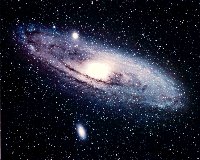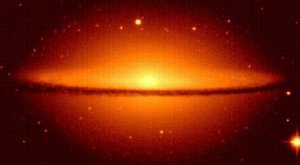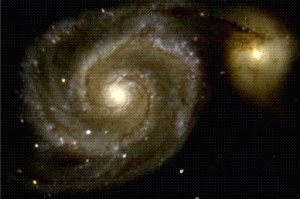|
|
|
 I'm fascinated with astronomy, so much so, that I have a 10 inch (25.4cm) f4.3 reflecting telescope, which is capable of seeing the galaxy in a lot of its glory.
The Web has loads of cool sites dedicated to astronomy, and many sites have some magnificent images taken by humble amateur astronomers like myself, to
the Hubble Telescope. If you click on the image here, it'll take you to a brilliant site, where you can download astronomical images (not in size!) of just about everything.
A brilliant site for learning about astronomy is the
Astronomy Picture of the Day.
The name says it all: every day there's a new image loaded, with a paragraph of information relating to it. Go and check it out sometime.
One of my friends Chris works at the Royal Greenwich Observatory (RGO) and
his homepage
has some information on that you might like to take a look at.
I'm fascinated with astronomy, so much so, that I have a 10 inch (25.4cm) f4.3 reflecting telescope, which is capable of seeing the galaxy in a lot of its glory.
The Web has loads of cool sites dedicated to astronomy, and many sites have some magnificent images taken by humble amateur astronomers like myself, to
the Hubble Telescope. If you click on the image here, it'll take you to a brilliant site, where you can download astronomical images (not in size!) of just about everything.
A brilliant site for learning about astronomy is the
Astronomy Picture of the Day.
The name says it all: every day there's a new image loaded, with a paragraph of information relating to it. Go and check it out sometime.
One of my friends Chris works at the Royal Greenwich Observatory (RGO) and
his homepage
has some information on that you might like to take a look at.
 A lot of people don't realise just how much you can see, even with the naked eye. It may come as a surprise to you that you can see most of the planets with the
naked eye when the night sky is clear. After all - think when they were discovered - no Hubble then!
There is a knack to looking at the night sky. First of all, try to choose a night when the moon isn't around. Any extra
light in the sky, will always obscure the faint light of distant stars and especially galaxies. That goes for street lamps as well - get away from them if
you can. When you come out of your brightly lit home, or out of your car and look up, you won't see much. The eyes have to acquire their night-vision. A lot of people don't realise just how much you can see, even with the naked eye. It may come as a surprise to you that you can see most of the planets with the
naked eye when the night sky is clear. After all - think when they were discovered - no Hubble then!
There is a knack to looking at the night sky. First of all, try to choose a night when the moon isn't around. Any extra
light in the sky, will always obscure the faint light of distant stars and especially galaxies. That goes for street lamps as well - get away from them if
you can. When you come out of your brightly lit home, or out of your car and look up, you won't see much. The eyes have to acquire their night-vision.
 This usually takes about 20 to 30 minutes. If you don' t believe me, try this: go outside on a dark night from a well lit room, and stand somewhere dark - ie.
where you can't see any lights. Now look up, and get a vague idea of how much you can see. OK - look away, but not at any lights, for around 10 minutes
or as long as you can manage. Now look up again. You'll see a huge number of stars, that you just couldn't see before. Still don't believe me?
Shine a torch in your eyes, and now have a look up. You'll be surprised!
This is why amateur astronomers get so hacked off when their family at home
open the curtains of a room that overlooks the garden you're observing in, just to see if you're alright. Nightmare!
When you've got your night vision, there's one more trick.
This one's pretty difficult to get used to, and takes time to learn. It's actually easier to learn with a telescope, due to the restricted field of view
you have. Look with the side of your eye, not directly at a star. You'll actually see more, because the cells on the retina that are more light sensitive -
the rods - are located away from the centre of your eye. It can help when learning to do this if you flicker your eye from direct vision to side vision periodically.
Happy stargazing! This usually takes about 20 to 30 minutes. If you don' t believe me, try this: go outside on a dark night from a well lit room, and stand somewhere dark - ie.
where you can't see any lights. Now look up, and get a vague idea of how much you can see. OK - look away, but not at any lights, for around 10 minutes
or as long as you can manage. Now look up again. You'll see a huge number of stars, that you just couldn't see before. Still don't believe me?
Shine a torch in your eyes, and now have a look up. You'll be surprised!
This is why amateur astronomers get so hacked off when their family at home
open the curtains of a room that overlooks the garden you're observing in, just to see if you're alright. Nightmare!
When you've got your night vision, there's one more trick.
This one's pretty difficult to get used to, and takes time to learn. It's actually easier to learn with a telescope, due to the restricted field of view
you have. Look with the side of your eye, not directly at a star. You'll actually see more, because the cells on the retina that are more light sensitive -
the rods - are located away from the centre of your eye. It can help when learning to do this if you flicker your eye from direct vision to side vision periodically.
Happy stargazing!
|
|
|


 I'm fascinated with astronomy, so much so, that I have a 10 inch (25.4cm) f4.3 reflecting telescope, which is capable of seeing the galaxy in a lot of its glory.
The Web has loads of cool sites dedicated to astronomy, and many sites have some magnificent images taken by humble amateur astronomers like myself, to
the Hubble Telescope. If you click on the image here, it'll take you to a brilliant site, where you can download astronomical images (not in size!) of just about everything.
A brilliant site for learning about astronomy is the
Astronomy Picture of the Day.
The name says it all: every day there's a new image loaded, with a paragraph of information relating to it. Go and check it out sometime.
One of my friends Chris works at the Royal Greenwich Observatory (RGO) and
his homepage
has some information on that you might like to take a look at.
I'm fascinated with astronomy, so much so, that I have a 10 inch (25.4cm) f4.3 reflecting telescope, which is capable of seeing the galaxy in a lot of its glory.
The Web has loads of cool sites dedicated to astronomy, and many sites have some magnificent images taken by humble amateur astronomers like myself, to
the Hubble Telescope. If you click on the image here, it'll take you to a brilliant site, where you can download astronomical images (not in size!) of just about everything.
A brilliant site for learning about astronomy is the
Astronomy Picture of the Day.
The name says it all: every day there's a new image loaded, with a paragraph of information relating to it. Go and check it out sometime.
One of my friends Chris works at the Royal Greenwich Observatory (RGO) and
his homepage
has some information on that you might like to take a look at.
 A lot of people don't realise just how much you can see, even with the naked eye. It may come as a surprise to you that you can see most of the planets with the
naked eye when the night sky is clear. After all - think when they were discovered - no Hubble then!
There is a knack to looking at the night sky. First of all, try to choose a night when the moon isn't around. Any extra
light in the sky, will always obscure the faint light of distant stars and especially galaxies. That goes for street lamps as well - get away from them if
you can. When you come out of your brightly lit home, or out of your car and look up, you won't see much. The eyes have to acquire their night-vision.
A lot of people don't realise just how much you can see, even with the naked eye. It may come as a surprise to you that you can see most of the planets with the
naked eye when the night sky is clear. After all - think when they were discovered - no Hubble then!
There is a knack to looking at the night sky. First of all, try to choose a night when the moon isn't around. Any extra
light in the sky, will always obscure the faint light of distant stars and especially galaxies. That goes for street lamps as well - get away from them if
you can. When you come out of your brightly lit home, or out of your car and look up, you won't see much. The eyes have to acquire their night-vision.
 This usually takes about 20 to 30 minutes. If you don' t believe me, try this: go outside on a dark night from a well lit room, and stand somewhere dark - ie.
where you can't see any lights. Now look up, and get a vague idea of how much you can see. OK - look away, but not at any lights, for around 10 minutes
or as long as you can manage. Now look up again. You'll see a huge number of stars, that you just couldn't see before. Still don't believe me?
Shine a torch in your eyes, and now have a look up. You'll be surprised!
This is why amateur astronomers get so hacked off when their family at home
open the curtains of a room that overlooks the garden you're observing in, just to see if you're alright. Nightmare!
When you've got your night vision, there's one more trick.
This one's pretty difficult to get used to, and takes time to learn. It's actually easier to learn with a telescope, due to the restricted field of view
you have. Look with the side of your eye, not directly at a star. You'll actually see more, because the cells on the retina that are more light sensitive -
the rods - are located away from the centre of your eye. It can help when learning to do this if you flicker your eye from direct vision to side vision periodically.
Happy stargazing!
This usually takes about 20 to 30 minutes. If you don' t believe me, try this: go outside on a dark night from a well lit room, and stand somewhere dark - ie.
where you can't see any lights. Now look up, and get a vague idea of how much you can see. OK - look away, but not at any lights, for around 10 minutes
or as long as you can manage. Now look up again. You'll see a huge number of stars, that you just couldn't see before. Still don't believe me?
Shine a torch in your eyes, and now have a look up. You'll be surprised!
This is why amateur astronomers get so hacked off when their family at home
open the curtains of a room that overlooks the garden you're observing in, just to see if you're alright. Nightmare!
When you've got your night vision, there's one more trick.
This one's pretty difficult to get used to, and takes time to learn. It's actually easier to learn with a telescope, due to the restricted field of view
you have. Look with the side of your eye, not directly at a star. You'll actually see more, because the cells on the retina that are more light sensitive -
the rods - are located away from the centre of your eye. It can help when learning to do this if you flicker your eye from direct vision to side vision periodically.
Happy stargazing!